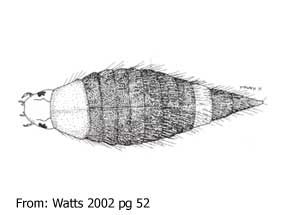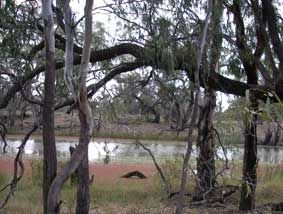Major Group: Insecta
Order: Coleoptera
Family: Noteridae |
Descriptive Features:
Adults
head not exserted
eyes usually in contact with anterior edge of pronotum, not completely divided
antennae entirely or almost entirely glabrous, 11-segmented
prothorax with pair of notopleural sutures separating notum from externally visible pleuron on each side
elytra concealing abdominal tergites
dorsal surface strongly convex
scutellum not visible
ventral surface flattened
abdomen with ventrite 1 divided into 2 or 3 parts by hind coxae
mesocoxal cavities open laterally
metasternum without transverse suture, if metasternal suture present, then elytra without regular puncture rows
metacoxal lateral portions longer than metasternum, metacoxal plates absent
metacoxae extending laterally to meet elytra, so that junction of metepimera and first ventrite is not visible, metacoxae with longitudinal plates covering bases of trochanters
junction between metasternum and metacoxae angulate in middle
forelegs not long and raptorial, middle and hind legs longer and narrower
fore tibia without antenna cleaner
tarsi always 5-segmented
size: 1.5 - 7mm
Larvae
head transverse and partly retracted into prothorax
antennae less than half as long as head width
mandible without mesal groove or internal perforation
labrum separated from head capsule by complete suture
body compact and fusiform
abdominal tergum 8 terminal, forming tapered process (siphon) bearing spiracles at apex, without ventral gills
urogomphi highly reduced and usually not visible
legs present
legs short and often concealed from above
size: 1.5mm |

|
Canthydrus bovillae larva |
|
|

|
Neohydrocoptus subfasciatus |
|
Taxonomic Checklist: Genera
Canthydrus 2 species
Hydrocanthus 3 species
Neohydrocoptus subfasciatus Sharp
Notomicrus tenellus Clark (larva unknown) |
|
Distribution: NE Qld, NT, N WA, S NSW, N NSW, Vic, SA
Sensitivity Rating: SIGNAL grade 4
Functional Feeding Group: predators (adults); larvae of Canthydrus and Hydrocanthus are predators, larvae of Neohydrocoptus and Notomicrus may be gathering collectors |

|
Billabong Creek on Old Coree nr Jerilderie, NSW |
|
|
Ecology: Instream habitat: Noterid beetles are found in the margins of shallow ponds, swamps and temporary puddles in woodlands. Adults and larvae usually live among the roots of floating or emergent aquatic plants.
Feeding ecology: Previously both adults and larvae of all Noteridae species were thought to be detritus feeders (Lawrence & Britton 1991), with the larvae usually feeding on the bottom. However, it is now known that the adults are carnivores, as are the larvae of Canthydrus and Hydrocanthus species (Watts 2002) but little is known about the larvae of other genera
Habit: Adults of most Noteridae species are capable of flight and are readily attracted to light. Some larvae obtain air using a spiracle-bearing siphon at the end of their abdomen to tap into hollow plants stems.
Life history: There is no information on Australian species. In Singapore, noterid pupae are found in air-filled cocoons attached to the roots of aquatic plants. |
| |
Information Sources: Lawrence & Britton 1991, Lawrence et al. 2002, Watts 2001, 2002, Toledo & Hendrich 2006, Hendrich et al. 2004
Key to Genera: Watts 2002 (adults and larvae)
Key to Species: Watts 2001 (adults partial)
Toledo & Hendrich 2006 (Hydrocanthus adults, inc. Asian species) |
|
|
|